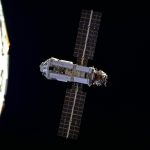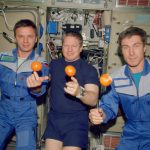
Humans have lived aboard the International Space Station for 15 years.
NASA
As of Monday morning humans have lived consecutively in space for 15 years. That’s longer than the iPod has existed and before Americans first learned of hanging chads during the contentious election between Al Gore and George W. Bush. During that time more than 220 astronauts and cosmonauts from 17 countries have visited and lived on the $ 140 billion International Space Station.
On the crystal anniversary of the station, which should fly until 2028, the six inhabitants on board didn't exchange gifts, but they did take a few moments to reflect on the accomplishment. "For me, the most important experiment is keeping humans alive for a long period of time," said NASA astronaut Scott Kelly. "All of this is something we're going to need to explore deeper into space for a longer period of time."
Keeping the football-field sized laboratory, which has an annual budget of about $ 3 billion, flying hasn't always been smooth sailing. In 2007, the three primary flight computers failed, leaving astronauts without control of its thrusters, oxygen generators, carbon dioxide scrubbers, and other environmental control systems. After several frantic hours they were able to reboot the system.
More recently, Italian astronaut Luca Parmitano's helmet began to fill with water during a spacewalk, an incident that could have been fatal had he not been rushed back inside an airlock. "The closest we've ever come to hurting someone was the Luca incident," then ISS program manager Mike Suffredini said. "It happened so fast, and it was over so fast, none of us had a chance to think about what was going on."
During the course of the station's lifetime, NASA has struggled with how to promote it. The ISS does many things, but there is no killer app to single-handedly justify its enormous cost.
On board the station NASA can test how astronaut health responds to long-duration spaceflight, as Kelly is now doing during his year-long mission. Yet Earth's Van Allen radiation belts protect the station, so NASA is unable to collect data about the most critical health threat facing astronauts on a mission to Mars—radiation from the Sun and cosmic rays originating outside the solar system.
The station also serves as a useful testbed for technology, such as its water recycler, needed for missions beyond low-Earth orbit. NASA recognizes the need for closed-loop systems for water and other consumables, but so far limited progress has been made on food, clothing, and other consumables that add considerable mass to long missions.
Finally, the agency has promoted the station as an important scientific laboratory for research in microgravity. The ISS does offer a unique platform, but despite some promising research, Earth-based labs with multi-billion-dollar budgets could unquestionably make more significant advances in various scientific fields.
Probably the most important contribution made by the station doesn't involve any kind of technology at all.
Rather, the station has proven an unqualified success in terms of international diplomacy. As US-Russia tensions deepened in the spring of 2014 following Russia's invasion of Crimea and undeclared war in the Ukraine, Russia's chief space official, Dmitry Rogozin, created a firestorm by saying if Americans didn't like his country's actions they could get to space by jumping on a trampoline. But that bluster never really went anywhere. Instead, US astronauts kept training in Star City, just outside of Moscow, and kept launching from the Baikonur Cosmodrome in Kazakhstan. Crews on board the station continued to work hand-in-hand, as did US flight controllers, with their Russian counterparts.
In reality, both the United States and Russia need the station. America has no other piece of human-rated space hardware, and without the station Russia's Progress and Soyuz vehicles have nowhere to go.

NASA
Expedition 1 crew members in Moscow. From left, Flight Engineer Sergei Krikalev, Expedition Commander William (Bill) Shepherd, and Soyuz Commander Yuri Gidzenko.

NASA
Expedition 1 crew members in Moscow. From left, Flight Engineer Sergei Krikalev, Expedition Commander William (Bill) Shepherd, and Soyuz Commander Yuri Gidzenko.

NASA
Launched in 1998 from Kazakhstan, the Zarya Control Module provides battery power, fuel storage, and rendezvous and docking capability for Soyuz and Progress space vehicles.

NASA
Launched in 2000, the Zvezda Service Module provides living quarters and performs some life support system functions.

NASA
In their flight suits, Expedition 1 joins hands before their launch. From left, Shepherd, Gidzenko, and Krikalev.

NASA
An aft view of the Soyuz rocket used to launch Expedition 1 into space.

NASA
The configuration of the ISS at the start of Expedition 1. From top to bottom, the three modules are: Unity, Zarya, and Zvezda.

NASA
One of the first images from Expedition 1, this shows Krikalev and Gidzenko at work in the Zvezda module.

NASA
Sixteen days into their mission, a Progress supply ship delivered two tons of food, clothing, hardware, and holiday gifts from families.

NASA
Krikalev works at a computer station in the Zvezda Service Module aboard the station. This is an early example of digital photography in space.

NASA
This shows Space Shuttle Endeavor approaching the space station, which was delivering a large truss and US solar arrays.

NASA
The Expedition 1 crew is about to eat fresh fruit in the form of oranges.
The US space station program began in the mid-1980s as Space Station Freedom, during the presidency of Ronald Reagan. It barely survived Congress and the administration of President Clinton, however, and only did so because it offered Clinton the opportunity to improve relations with post-Soviet Russia.
After more than a decade of planning, Russia and the United States began launching components of what became known as the International Space Station in 1998, and on the morning of November 2, 2000, Expedition 1 Commander Bill Shepherd, Soyuz Commander Yuri Gidzenko, and Flight Engineer Sergei Krikalev maneuvered their Soyuz spacecraft into its docking port. Once inside, one of their first tasks was to activate its toilet.
NASA has proven that it can collaborate with its former Cold War enemy on major space projects. The agency could probably collaborate with China as well, although Congress currently prohibits such cooperation. This matters. If NASA is really serious about mounting a mission to Mars, it will need lots of international partners.
The reasons are two-fold. First, other nations may contribute money and hardware. France, for example, might be able to devise a nuclear power station for a Mars base. Secondly, and perhaps most critically, the space station program has survived for more than two decades precisely because of its international association. Subsequent presidents haven't canceled the program because it provides one of America's only bonds to Russia, as well as longterm agreements with key European and other international partners.
Any mission to Mars will require at least 15 or 20 years to plan and execute, spanning multiple presidential administrations. Having commitments to international partners would, to a large extent, lock in new presidents to such a plan and not subject NASA to the vagaries of new administrations and Congresses.
So today, after 15 years of providing a safe harbor for humans off the planet Earth, what the International Space Station really represents is a diplomatic template for extending the reach of humanity deeper into the solar system.
No comments:
Post a Comment